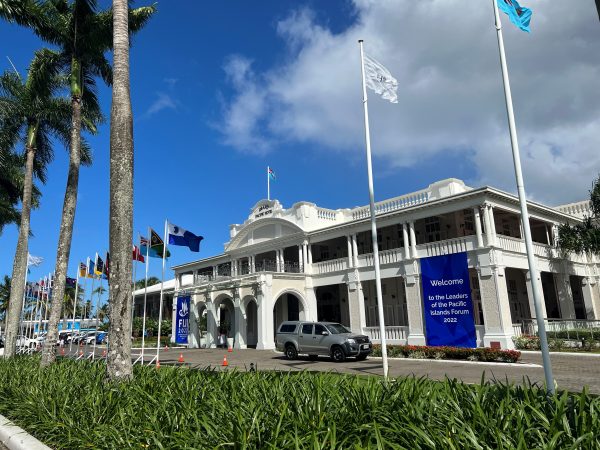Australia remains the biggest aid donor to the Pacific. But, in contrast to China, Australian investments in the region are not always visible. This led to an increased focus on infrastructure investments.
Many in the development community have argued that physical infrastructure cannot stand alone without concurrent investments in social infrastructure, especially given the income and opportunities lost during the COVID-19 pandemic. They propose that infrastructure projects should be supplemented by additional social programs, for example, leveraging electrification and internet expansion for health, education and social payment outcomes for long-term development.
Instead of playing the same game as its perceived competition, Australia can articulate its aims for the Pacific in terms that work to its comparative soft power advantage while also addressing the broad range of human development challenges facing Pacific island countries.
Australia should focus on infrastructure that supports economic growth over the long term. Australian bilateral and collaborative investments with partner donors should build the health, education and social protection systems that Pacific Island countries need for coming generations. It should focus on improving resilience and social cohesion, building human capital and advancing human security as part of a geo-economic strategy with social infrastructure at its centre.
Because the Pacific has been receiving significant infrastructure financing, it is becoming harder to justify funding marginal projects. Infrastructure will be increasingly about service delivery, with a need to move away from large-scale projects to the maintenance of existing infrastructure, small-scale capital projects and climate adaptation. These are the areas that will have the highest economic return.
The dispersed nature of populations in smaller outlying islands in most Pacific Island countries means that small-scale financing and recurrent expenditure for the maintenance and operation of infrastructure is the best long-term investment. ‘Build and forget’ is not a viable model and a ‘lifetime engagement’ approach offers a potential point of distinction for Australian infrastructure.
Australia should consider sustainability as part of its capital projects and prioritise climate resilience. It should focus on investing in appropriate technology — infrastructure that can be of most benefit to the most people over generations. Casting a gender lens on infrastructure is an important element in making that cost–benefit analysis.
Building capacity, utilising renewables and making use of local materials are all key for sustainability. Australia should prioritise initiatives and models that deliver social, economic and environmental benefits. These include innovative green infrastructure approaches, ecosystem-based resource management and nature-based disaster risk reduction solutions.
The area where hard infrastructure should remain a focus is technology. From Canberra’s perspective, digital linkages across the Pacific directly impact Australia’s national security. Malicious state or state-sponsored actors are active in cyberspace around the world and the Pacific is not immune.
Insufficiently protected vectors could provide avenues for hostile actors to gain access to Australia’s critical infrastructure, so raising the capabilities and defences directly benefits both Australia and Pacific Island countries. Other actors in the region are providing the infrastructure, skills and knowledge to support Pacific ambitions on digital connectivity. Australia must ensure it does not leave a vacuum in the Pacific digital space.
Canberra has a clear role in financing the physical infrastructure required to build Pacific connectivity. The Coral Sea cable network, an undersea cable system linking Sydney, Port Moresby and Honiara, is a good example of Australia connecting Pacific Island countries to global information flows. Australia is working collaboratively with other actors in this area, partnering with Japan and the United States to finance an undersea cable to the Republic of Palau and with New Zealand, Japan and the United States to deliver on the Papua New Guinea Electrification Partnership.
But there are still opportunities for Australia to increase its regional connectivity, such as through the USAID’s Digital Connectivity and Cyber Security Partnership activity in the Pacific.
The provision of digital connectivity goes beyond providing technology and requires affordability of access. Australia can provide practical assistance at the local level, such as simple solar technology to enable phone charging. Infrastructure needs to address the different levels of development across the region where, for example, Fiji aspires to become a cyber hub while Papua New Guinea is focussed on providing its population’s basic electricity needs.
To avoid adding to Pacific debt burdens, Australia should enhance the number of its concessional loans. The repurposing of the US$3 billion non-concessional loan component of the AIFFP into more concessional loans or grants would help free-up additional resources to fund social infrastructure such as health facilities and support a ‘pro-poor’ economic recovery.
This is particularly important for Papua New Guinea and other Pacific Island countries which have limited international borrowing options and rely largely on multilateral development banks (with already stretched resources) or loans from China.
Melissa Conley Tyler is program lead at the Asia-Pacific Development, Diplomacy & Defence Dialogue (AP4D).
Alexandre Dayant is Project Director, Development Economics in Asia and the Pacific at the Lowy Institute.
This piece draws on a recent report and AP4D thanks all those involved in consultations.

